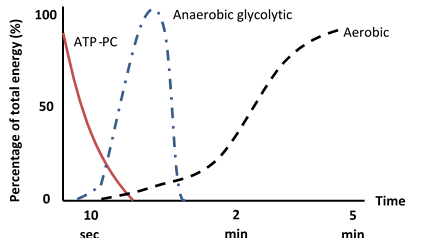Note that your final mark will not be saved in the system.
3.1.1.6 Energy systems GapFill
You must fill all the gaps before clicking ‘Check Answers!’

Adenosine triphosphate (ATP) is the energy of living cells. The hydrolysis (breakdown) of ATP is catalysed by the enzyme ATPase, releasing the energy required to drive the processes of cells. In the case of muscles, this is to enable contraction. As well as the energy produced, other components of its breakdown are adenosine diphosphate (ADP) and inorganic (Pi).
These components are used to resynthesise ATP in the reversible reaction:
- ATP = ADP + Pi + energy
The energy used in this reaction comes from the three main energy systems. These can be placed on an energy , which characterises the different rates at which, and the duration for which, they are able to resynthesise ATP. The predominant system used depends on the intensity and duration of exercise (i.e. the demand for ATP at the muscle and the rate and capacity of each system to provide this).
| The ATP- (PC) system provides the most rapid generation of energy for the cell, so is used at the onset of exercise regardless of intensity. If intensity is maximal, then this system will be the predominant supplier of energy for up to ~ seconds. Energy production through this pathway mainly takes place in fast-twitch fibres, due to their ability to contract with speed. Once the limited store of PC in the muscle is depleted, the ATP demands at the muscle exceed the rate at which it can be supplied, and so exercise intensity must reduce as a consequence. |
| The anaerobic system takes over as the predominant supplier of energy. The reactions taking place result in the accumulation of lactic acid as a by-product, which is associated with the reduction in in the cell and inhibition of the processes involved in muscle contraction. Once this by-product reaches a value of 4 mmol/L, the (OBLA) is said to occur. Fitter individuals are better able to resist fatigue caused by lactate accumulation than their untrained counterparts, thus having an improved lactate-producing capacity, and are more adept at sprint and power events. |
The aerobic energy system uses both and as main sources of fuel for exercise. The former has an average storage capacity of ~600 g in the , but because of the large storage capacity of the latter, this energy system can be used almost indefinitely. Therefore, it is the predominant energy system used in long-duration events at an intensity equating to or occurring below the . This is the first notable rise in blood lactate during exercise, usually at 2 mmol/L above the resting value. Energy production through the aerobic energy system mainly takes place in slow-twitch fibres, due to their slow speed of contraction. |
Recovery of energy systems:
The duration at which energy supply can last with each system is correlated with the length of time each takes to recover. It is also dependent on the intensity and duration of each exercise bout, but it is often stated that around 50 % of initial PC stores are resynthesised after ~30 seconds of recovery, with the ATP-PC system making an almost full recovery in ~3–4 minutes. The system would be unable to make a full recovery during intermittent exercise, due to the removal of harmful waste by-products taking roughly between 20 minutes and two hours. During intermittent exercise, there is enough fuel availability present with the aerobic energy system to maintain supplies of ATP.